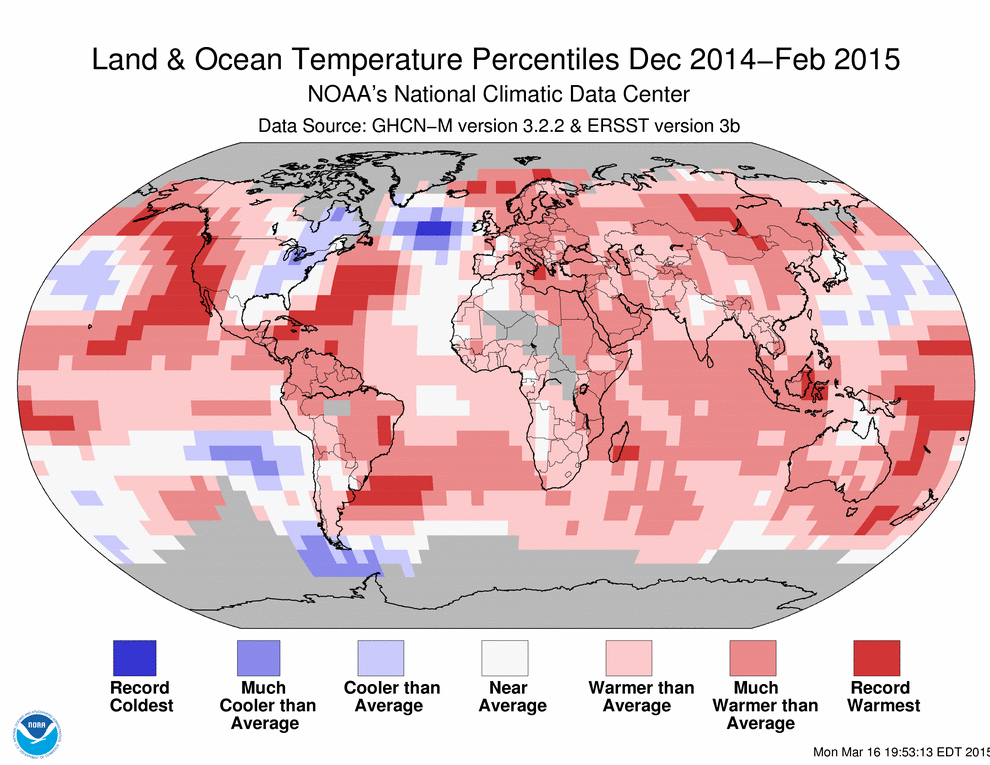The world’s most famous climate scientist just outlined an alarming scenario for our planet’s future
especiales

With his 1988 congressional testimony, the then-NASA scientist is credited with putting the global warming issue on the map by saying that a warming trend had already begun. “It is time to stop waffling so much and say that the evidence is pretty strong that the greenhouse effect is here,” Hansen famously testified. Since then, he has drawn headlines for accusing the Bush administration of trying to muzzle him, getting arrested protesting the Keystone XL Pipeline, and setting forward the case for why carbon dioxide levels need to be kept below 350 parts per million in the atmosphere (they’re currently around 400).
Now Hansen — who retired in 2013 from his NASA post, and is currently an adjunct professor at Columbia University’s Earth Institute — is publishing what he says may be his most important paper. Along with 16 other researchers — including leading experts on the Greenland and Antarctic ice sheets — he has authored a lengthy study outlining an scenario of potentially rapid sea level rise combined with more intense storm systems.
It’s an alarming picture of where the planet could be headed — and hard to ignore, given its author. But it may also meet with considerable skepticism in the scientific community, given that its scenarios of sea level rise occur more rapidly than those ratified by the United Nations’ Intergovernmental Panel on Climate Change in its latest assessment of the state of climate science, published in 2013.
“We conclude that 2°C global warming above the preindustrial level, which would spur more ice shelf melt, is highly dangerous,” note Hansen and his co-authors. 2 degrees Celsius is a widely accepted international target for how much the world should limit global warming.
The research is slated to appear this week in Atmospheric Chemistry and Physics, an open-access journal published by the European Geosciences Union in which much of the peer review process, in effect, happens in public — a paper is uploaded, and then other scientists submit comments on it, and then the authors respond.
The research takes, as one of its starting points, evidence regarding accelerating ice loss from some parts of the planet’s ice sheets, especially West Antarctica. One of Hansen’s co-authors on the new paper, Eric Rignot of NASA, was the lead author of a 2014 study suggesting that, as one NASA press release put it, the decline of West Antarctica could now be “irreversible.”
In the new study, Hansen and his colleagues suggest that the “doubling time” for ice loss from West Antarctica — the time period over which the amount of loss could double — could be as short as 10 years. In other words, a non-linear process could be at work, triggering major sea level rise in a time frame of 50 to 200 years. By contrast, Hansen and colleagues note, the IPCC assumed more of a linear process, suggesting only around 1 meter of sea level rise, at most, by 2100.
“If the ocean continues to accumulate heat and increase melting of marine-terminating ice shelves of Antarctica and Greenland, a point will be reached at which it is impossible to avoid large scale ice sheet disintegration with sea level rise of at least several meters,” the new paper says.
Using climate models and an analogy with the so-called Eemian period or “Marine isotope stage 5e” — an interglacial period some 120,000 years ago that featured considerable sea level rise — the paper goes on to suggest that major ice loss from both Antarctica and Greenland will change the circulation of the oceans, as large volumes of cold, fresh water pour into the seas. This freshening or decreasing saltiness of the ocean, at both poles, could ultimately block the oceans’ overturning circulation, in which (in the northern hemisphere) warm water travels northward, and then colder, denser water sinks and travels back south again.
As the paper notes, there is already evidence of such cooling in the north Atlantic — presumably due to ice loss from Greenland. Note the large blue (cold) anomaly from this recent analysis of last winter’s global temperatures by the National Climatic Data Center:

According to the National Climatic Data Center, the world just saw its warmest winter ever…except for in one spot in the north Atlantic ocean (the deepest blue color above), which set a record for cold. Which is not good. (NCDC)
Around Antarctica, meanwhile, sea ice has been growing — potentially another indicator of cooling and freshening at the ocean surface due to ice loss from the continent.
In the model employed by Hansen and his coauthors, this cooling and freshening of the oceans eventually leads to a shutdown of the oceans’ circulation, and warm waters trapped at depth below a cold fresh surface layer in the Antarctic region, continually eating away at ice sheets from below. It also triggers a globe with ever-warming tropics but cold poles — leading to a large contrast in temperatures between the mid-latitudes and the polar regions.
A larger temperature contrast between the tropics and the poles, the researchers posit, would then strengthen winter storms or so-called extratropical cyclones, which draw their energy from such contrasts. The study therefore contemplates more powerful storms. It notes research suggesting that in the Eemian period, the last time the world saw major sea level rise of as much as 5 to 9 meters (between 16 and 30 feet), gigantic waves //www.uow.edu.au/content/groups/public/@web/@sci/@eesc/documents/doc/uow014953.pdf">apparently moved huge boulders from the seafloor to the top of hills in the Bahamas.
“During this last warm interglacial, not much warmer than the present, [the world saw] not only a higher than present average sea level, but ultimately a significantly higher sea level that required the melting and or collapse of probably both Greenland and West Antarctica, along with basically this great oceanic disturbance,” says Paul Hearty, a geologist at the University of North Carolina, Wilmington who is one of Hansen’s co-authors on the new paper, and conducted the research on the Bahama boulders. “There were storms, and a lot of more catastrophic type events associated with this big climate shift.”
The Eemian, the research suggests, may have only reached global average temperatures about 1 degree Celsius warmer than today — but nonetheless, featured these major changes.
This scenario all depends, of course, on major ice loss from Greenland or Antarctica happening relatively quickly — an assumption that lies at the center of the new paper. “Ice mass losses from Greenland, West Antarctica and Totten/Aurora basin in East Antarctica are growing nonlinearly with doubling times of order 10 years,” notes the study. Elsewhere, it notes that “Doubling times of 10, 20 or 40 years yield sea level rise of several meters in 50, 100 or 200 years.”
And while the paper doubts whether a continued, non-linear growth will be possible for Greenland, it concludes that “if [greenhouse gases] continue to grow, the amplifying feedbacks in the Southern Ocean, including expanded sea ice and [Southern ocean overturning circulation] slowdown likely will continue to grow and facilitate increasing Antarctic mass loss.”
So is this abrupt climate change scenario really something we should take seriously? Michael Mann, a climate researcher at Penn State University who reviewed the paper at the Post’s request, commented by email that “their case is most compelling when it comes to the matter of West Antarctic ice sheet collapse and the substantial sea level rise that would result, potentially on a timescale as short as a century or two.” But Mann was more skeptical of other aspects of the work.
“Their climate model scenario wherein Greenland and Antarctic meltwater caused by warming poles, leads to a near total shutdown of ocean heat transport to higher latitudes, cooling most of the globe (particularly the extratropics), seems rather far-fetched to me,” Mann said. Nonetheless, Mann said, “Whether or not all of the specifics of the study prove to be correct, the authors have initiated an absolutely critical discussion.”
“I agree that 2 C warming is dangerous and will very likely commit our home planet to meters of sea-level rise,” added Stefan Rahmstorf of the Potsdam Institute for Climate Impact Research, an expert on sea level rise and the oceans’ overturning circulation, by email. Rahmstorf had not yet had time to review the full Hansen paper Monday, so his comment was strictly about the danger of major sea level rise, not the other scenarios outlined in the study. He has previously suggested that the Eemian may not be the best analogy for where the planet is headed, given that changes at that time were driven by planetary orbital cycles, rather than carbon dioxide emissions.
The paper is long and very detailed, drawing on expertise on ice sheets, the oceans, storms, and past climates — it will surely take a while for scientists to determine what they think. But skepticism is likely, given not only the nature of scientists in general, but also the significant departures from the view of a consensus body — the IPCC.
“Something like this very much needs peer review because of uncertainties in paleo data, major errors in climate models so they do not necessarily provide the right guidance, and so forth,” said Kevin Trenberth, an influential climate change researcher with the National Center for Atmospheric Research in Boulder, Colorado, who had not yet read the study.
“You can see a lot of different points in this paper, and it’s going to take a while for the community to sort them out, but actually, the story is clear,” says Hansen. The bottom line conclusion, he says, is that sea level rise is “the big impact of human made climate change.”













Add new comment